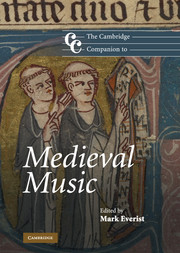2 - Enriching the Gregorian heritage
from Part I - Repertory, styles and techniques
Published online by Cambridge University Press: 28 September 2011
Summary
New music in Francia
In 843, Charlemagne's descendants met at the city of Verdun and divided the Carolingian empire into three kingdoms. By this time churches and monasteries from Aquitania to Saxony were, for the most part, observing a common liturgy based on Roman practices. The stability of this Gregorian rite, its ability to survive the political division of the empire, rests on the success of the educational programmes Charlemagne established in the late eighth century. The Carolingian emphasis on literacy, musicianship and the accurate reproduction of books all provided a solid foundation for the new liturgy, and the ninth-century canons and monks who inherited the newly forged rite developed a wide variety of tools – tonaries, theory treatises, and musical notation itself – to preserve and pass down this legacy.
The division of the Carolingian empire in 843 had important consequences for the history of music. The Treaty of Verdun polarized the European continent, creating Eastern and Western realms divided roughly by the Rhine river. The geographic division is reflected in the emergence and development of two musical traditions. Whereas chants that entered the liturgy before the early 840s appear in books across the European continent with substantial fixity, melodies that were composed later, in the late ninth, tenth, and eleventh centuries, tend to appear exclusively in sources either east or west of the Rhine. After about 1100, the boundary between East and West became more permeable, and the wide dissemination of chant once again became common.
- Type
- Chapter
- Information
- The Cambridge Companion to Medieval Music , pp. 26 - 45Publisher: Cambridge University PressPrint publication year: 2011
- 1
- Cited by



